Wood Heaters—One Cheer for Trump EPA’s Modest Regulatory Reform

 The Trump administration’s reforms of past regulatory excesses range from excellent to little better than no change at all. The U.S. Environmental Protection Agency’s (EPA) recent coronavirus-inspired modification to wood heater regulations is definitely an example of the latter.
The Trump administration’s reforms of past regulatory excesses range from excellent to little better than no change at all. The U.S. Environmental Protection Agency’s (EPA) recent coronavirus-inspired modification to wood heater regulations is definitely an example of the latter.
Wood heaters are an economical source of heating, especially in rural areas where wood is cheap and plentiful. In 2015, the EPA finalized its first comprehensive emissions limits for them since 1988, pursuant to the Clean Air Act’s New Source Performance Standards (NSPS) program. The rule set out a two-step process. Standards calling for sharp reductions in emissions took effect immediately in 2015, and an even more stringent second phase targeting much of the remaining emissions would take effect May 15, 2020.
Step one, which provided the bulk of the emissions reductions, went into effect with minimal difficulties and only a small cost increase for consumers. In contrast, step two proved to be much more of a challenge. Anticipating problems getting models certified to meet the step two requirements by the 2020 deadline, as well as fears of sharp price increases, the Hearth, Patio and Barbeque Association requested help from Congress. As a result, the House passed a bill in 2017 that would push back the step two deadline to 2023. However, there never was a Senate companion version and the effort collapsed.
The industry then sought help from the Trump EPA. In response, the agency proposed a rule allowing the remaining step one wood heaters manufactured before the May 15 deadline to still be sold after it—a so-called sell-through provision. Doing so is not nearly as useful as pushing back the step two deadline, but it would help prevent both manufacturers and retailers from getting stuck with step one-compliant heaters they could no longer legally sell. It would also make the more affordable step one models available to consumers for a bit longer. However, the agency decided not to grant a sell through period in its April 2, 2020 final rule.
The need for relief for makers and users of wood heaters is substantial. Most of the manufacturers in this sector are small companies that cannot afford expensive product redesigns and stranded inventory. Frank Moore, president of Hardy Manufacturing in Philadelphia Mississippi, who testified before Congress in favor of the House bill, says his company has since cut back production and staff as a result of the rule. In truth, a mere sell through provision probably won’t be enough to prevent further industry damage, but it may help reduce it a little.
Likewise, many purchasers of wood heaters are low-income rural households that can ill-afford the price hike associated with step two-compliant models. Thus, some are likely to continue using older and dirtier wood heaters or open fires with no emission controls at all. Thus, a sell-through provision would provide consumers with a modicum of relief and may lead to reduced emissions.
On May 15, the EPA reversed course and again proposed a limited sell-through period until November 30, 2020 for the remaining step one models. EPA Administrator Andrew Wheeler explained that the disruption caused by COVID-19 interfered with the final months of step one wood heater sales, so the agency is proposing to provide additional time.
Even this very limited relief has sparked fierce opposition and over-the-top claims of harm. For example, a letter from Sen. Tom Carper (D-DE) warns the EPA that such a sell-through period would pose a dire public health threat for decades to come. In reality, the difference in emissions between step one and step two is relatively small, and a limited sell-through period for the former would have an unmeasurably trivial impact on air quality.
However, there is a lesson in this—if weak regulatory reforms will be attacked just as much as strong reforms, the EPA might as well do strong ones. And in this case, revisiting the May 15 step two deadline in light of COVID-19 would have made sense.